|
Monday, Janury 19, 2009
Progress Notes
A couple of weeks ago I presented articles about the German immigrants to Miller County. This week I thought it would be interesting to present information about some of the first immigrants to our county, the Osage Indians. I had presented some of this information before in June of last year. However, this week I wanted to present a Peggy Hake research article about the Osage Indians of Miller County (photo 01).
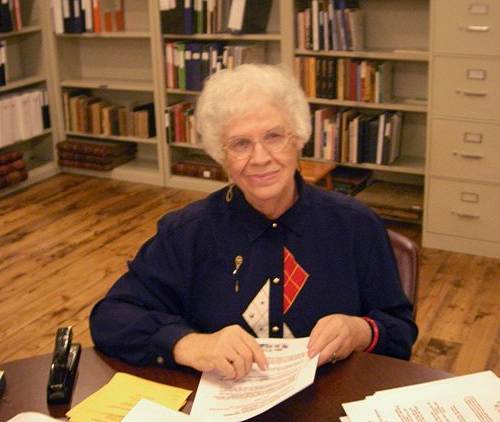
01 Peggy Hake
As usual, Peggy has researched the article very thoroughly and provides interesting insight to her story of our first citizens of Miller County:
The Osage Indians of Miller County
Peggy Hake
The Osage Indians were a tribe of the Siouan race (photo 02).
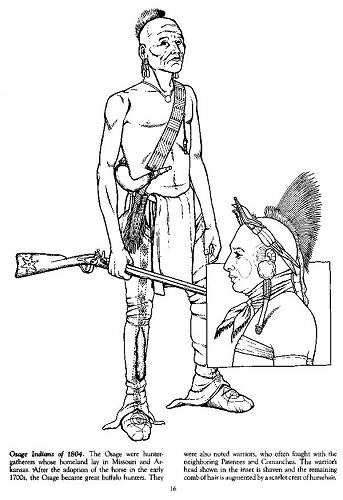
02 Osage Indians
Click image for larger view
Their name was Wazhazhe, which in the Osage language meant “war people.” The Frenchmen who came into the area to hunt and trap corrupted the name to Osage and it remained so for over two centuries (photo 03).
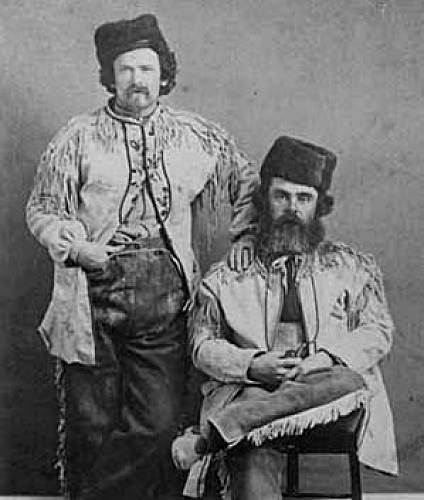
03 French Trappers
Had the Indian spelling remained, we might be referring to “crossing the Wazhazhe River at Tuscumbia!” They came from the Ohio River Valley many years before the first white man ever settled in Miller County. They were closely related and allied to the Omaha tribe who went further northwest and settled in Nebraska. Our Osage River was named for this tribe and it runs for 500 miles through Kansas and Missouri eventually emptying into the Missouri River at Osage City (photo 04).
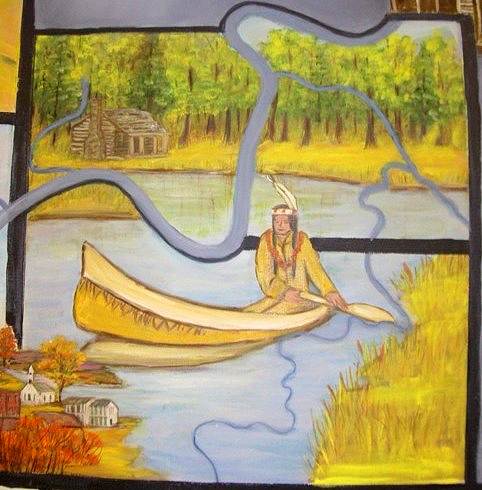
04 Osage Indian in Canoe
These Siouan Indian tribes once inhabited the West central United States and central Canada, parts of Virginia, and the Carolinas. Other branches of the Siouans were (1) the Omaha tribe who came from the Ohio River Valley and ventured on northward, eventually settling in northeast Nebraska; (2) the tribes of the Catawba (originally in South Carolina where a river was named for them); (3) the Winnebago who settled in eastern Wisconsin and Lake Winnebago was named for them; (4) the Dakota/Siouxs who settled the northern plains of the United States; (5) and the Crow who settled the upper basin of the Yellowstone and Big Horn rivers in Wyoming. These different Indian groups had evidently once been one, large tribe of people, who in prehistoric times, had controlled the valleys of the Ohio and Wabash rivers. The river valleys were dotted with their villages, burial grounds, and cornfields. They decided to explore further west and discovered the mouth of the Missouri River north of present day St. Louis. They settled there for awhile, but ventured further up the mighty Missouri. Part of the tribe broke away and moved downstream into what is now Arkansas and became the Quapaw Indians. On the way upriver on the Missouri, these tribes split at least two more times. One left the mainstream and went southwest on a smaller river….these people became the Osage tribe. Another group ventured up another tributary into central Kansas and settled, giving their name, in time, to both a state and a river. The rest of the tribes pushed into Iowa and onward into southern Minnesota and Wisconsin on smaller streams becoming part of the Omaha and Winnebago tribes. Two early major trails through Miller County, Old Harmony Mission Trail to Missouri River and Osage Trail to Gasconade River have been mapped (photo 04a).
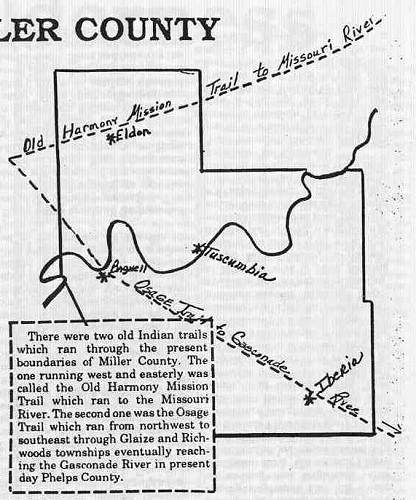
04a Indian Trails
Click image for larver view
But even earlier in the land we know as Miller County, lived Mound dwellers who inhabited this area centuries ago (photo 05).
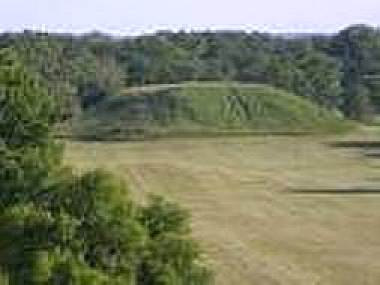
05 Missouri Mound
They built their strange formations along the Osage River bluffs and in the bottoms, as well as on the Grand Auglaize and Big Tavern creeks. One was on the John Malmberg farm near the Madden Ford in Richwoods township. Archealogists from the University of Missouri have excavated in some of these locations and have found pottery pieces, ashes, stone axes, charcoal, etc. It is believed they were not used as burial sites, but were places which marked battle grounds or ceremonial spots of the honored ones among those obscure people whom we know so little about. In the 1880’s, one of the mounds was located on the Joseph M. Coburn farm in Glaize township. Also in the’80’s, two Miller County residents were recorded having very good archaeological collections including John D. Brown of Iberia and Captain Theodore B. Robinson of Tuscumbia. I do not know what happened to those unique collections over the past 100 years.
It is recorded that about 1822 there was an Indian village in Richwoods Township near Wilson’s cave where the Barren Fork creek converges with the Big Tavern (photo 06).
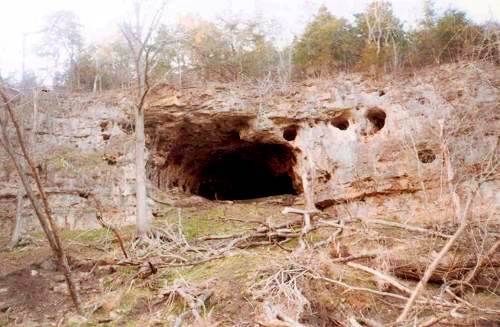
06 Wilson Cave
Just about the same year, John and Nellie Wilson came to Miller County and sat up residence in a cave above the Big Tavern. The Indians, who evidently were friendly neighbors of John and Nellie, gave them some wild pigs from their herds by which they began their own swine herd. They probably learned from one another in the years they co existed near each other on the Big Tavern.
Four Osage Indian men have remained in Miller County’s history over the years. The first was Joe Munsey who remained here after his tribal brothers moved on west. During the War of 1812, Joe served with the United States military under the command of General Andrew Jackson and took part in that famous battle fought on January 8, 1815 at New Orleans. Another Osage Indian who remained in the area for awhile was named George Tall Bear who lived in the area of present day Iberia. His name appears in old surveyors records as they surveyed the land in the Big Richwoods around Iberia in the 1830’s. His name was written as George Tol Bear in the old journals. No one seems to know what happened to him. Josiah Birdsong, an early settler, purchased Tall Bear’s land and settled on it. Tall Bear told Josiah that when he was only a youth, he had hunted buffalo which roamed the grassy prairies of the Big and Little Richwoods of southern Miller County. There is a legend of another Osage Indian who remained in the county for awhile as well. He was an old warrior, simply called “Cadle,” who lived in a three cornered log house near Dog Creek south of the Osage in Equality Township. His primitive home was located near the place where Highway 52 crosses Dog Creek today. The hollow bears his name to this day…Cadle Hollow (photo 07).
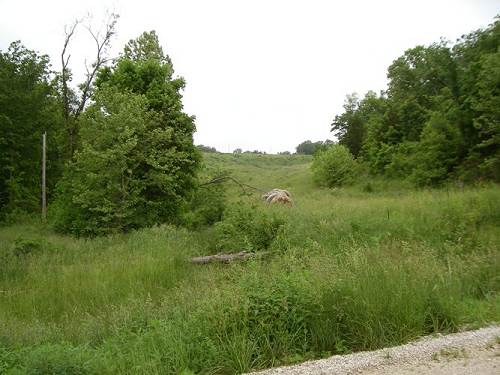
07 Cadle Valley
Probably the most famous and best known of the Osage Indians who remained in Miller County after the white man arrived was named Jim Henry. I am assuming he had a tribal name of the Osage language, but was dubbed Jim Henry by his white friends who homesteaded in the new frontier of Missouri territory. He was probably the last of the Osage tribe to live in Miller County and he was so popular that his name remains today in our county’s annals….a township, a creek, a cave, a church, a road, and a school were named for him! Jim Henry, his wife, and children lived in a remarkable, natural stone house built by Mother Nature. Today it still stands on a hillside overlooking a beautiful green meadow and Highway 17 can be seen about one half mile to the west (photo 08).
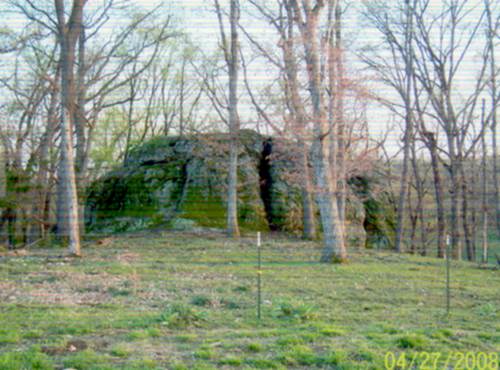
08 Jim Henry Rock Cave "House"
I visited this old stone cave a few years ago and I was astounded at my first glimpse of this rock home which is nothing more than an enormous freak rock formation sitting atop the hillside. The residents of Jim Henry Township refer to it simply as “the rock house.” It is about 60 feet in length, is circular in shape and about twenty to thirty feet high. With animal skins stretched over poles and used as walls to hold out the winter’s cold, I could easily see how this Indian family lived comfortably in their “rock house.” What happened to Jim Henry and his family is unknown. They disappeared from Miller County in the time era of the late 1830’s or early 1840’s and were never heard from again. In 1854, a man named Samuel Greenup patented the land on which the “rock house” was located and since that year various families have owned the land including the Martins, the Fowlers, Winters, Tellmans, Johnstons, Albertsons, and the Schultes. As I left the hillside that day, where stands the beautiful “house of stone,” my one thought was simply this…”Oh! If only those ancient walls could speak.”
The chief town of the Osages was in Vernon County, Missouri. In 1719, a Frenchman named Claude DuTissent (French trapper) visited with the Osage tribes and hunted with them for awhile. By 1785, the Spanish authorities built Fort Carondelet on the same spot. Pierre Chouteau, Sr. a resident of the new city of St. Louis was appointed Commandant at the Fort. Some of the other hunters who traveled the Osage in the trading business were John B. Mathurin in 1807, Joseph Dion and Baptist Gouveville also were there the same year. In 1804, at St. Louis, the Treaty of St. Louis bound the Osage Indians in harmony with the Sacs and Foxes tribes and about this same time there was another branch of the Osage called The Little Osage (which meant Campers of the Lowlands) who came to dwell with the more powerful tribe, raising the number of warriors to 1300 and the number of the tribe to 6300. In 1898, they ceded a huge grant of land to the United States and at that time Fort Osage was built a few miles east of Kansas City.
The Osages were the tallest race of men in North America. Very few were under 6 feet tall and some reached 7 feet in height (photo 09).
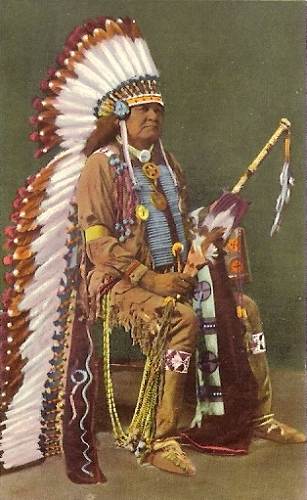
09 Indian Chief Full Dress
They shaved their heads and then painted them. Their ears were cut and pierced and they wore large earrings and ornaments. It was said they also tattooed their bodies. Even though they were noted mainly as hunters, they also raised small crops of beans, corn and pumpkins. They knew the art of preserving and drying these crops for use in the harsh Missouri winters. They saved and stored enough for consumption during the cold weather months and also knew the knack of drying their meats. They stayed close to the villages and their families from about Christmas time to late February or early March. They would then venture out on hunting expeditions. Other things of nature they used in their diet were paw paws, hog potatoes, and many different kinds of roots which were dug for medicinal purposes.
Note: Our Native American artifact collection which currently being expanded and reorganized by Ellis Bray of Eldon, has a number of locally found Osage Indian artifacts on display (photos 10, 11 and 12):
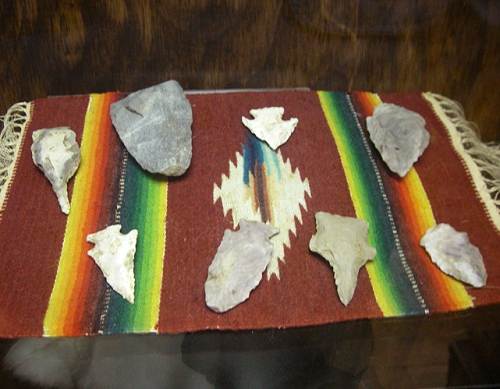
10 Arrowheads
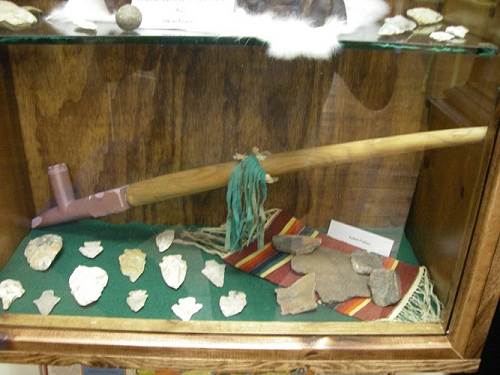
11 Arrowheads and Peace Pipe
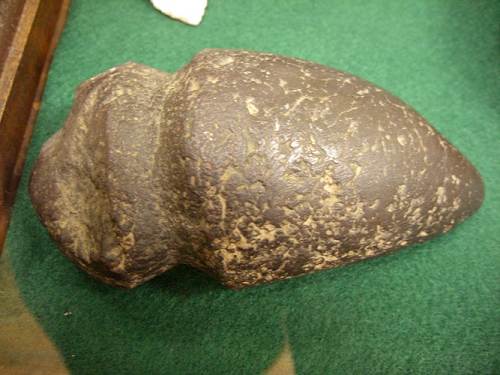
12 Tomahawk
It has been legend that the Indian’s skin was red, but that was not always true. Many tribes were pale skinned and some of the first explorers into the inner regions of America were surprised by these light skinned natives who had “fair skin, blue eyes, chestnut or auburn hair.” The Osages were of a medium skin tone and were exposed to the elements in all seasons of the year.
Also, almost every American Indian tribe had a legend of a huge flood and some even described an “Ark!” They called it the “Big Canoe.” One of the legends of the Indian was the following: They believed all of the tribes of the Indians were formerly one, and all dwelt on an island or at least across a large body of water toward the east or sunrise. They crossed this water in skin canoes or by swimming, but knew not how long it took them to cross nor where they landed. Historians seem to believe these ancient legends point toward the fact that these tribes had memories of ships and a long sea voyage!
As late as 1900, some Osage Indians came into the Iberia area and camped out a few days on one of the south hillsides we know today as Mockingbird Hill. They did not disturb anyone at the time; merely camped out awhile and eventually left as quietly as they came.
A wonderful story was told me by Harvey Smith of Chesterfield, Missouri. He said this story had been passed down through his wife’s family who had lived in the Osage River area of Miller County:
“One day, in the late 1920’s, two cars drove to the home of Charles P. Tellman who lived near the Osage River. Mr. Tellman’s home was steeped in history because the first county court had been held within its walls in 1837. A one room log cabin had been built by William Miller about 1834 and over the years, more rooms were added. By the time the Tellmans occupied the home it had grown considerably in size (photo 13).
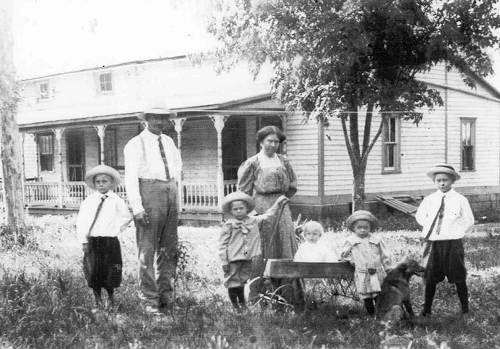
13 Tellman Home before 2nd Addition - 1916
Left to Right: William, Charles, Leonard, Josephine, Edwin, Harold and Frank
As the two cars approached the front gate, Mr. Tellman greeted the strangers who turned out to be genuine American Indians. They asked Mr. Tellman a very strange question…Could they please look around the place and do some digging if necessary? His curiosity overcame his objections so he said, “Yes.” In a short while they approached Mr. Tellman and said, “We have found the spot and we need to do our digging now.” The spot happened to be under the steps leading to his back porch. He needed more of an explanation, of course! The old Indian, who must have been their Chief, said, “My grandmother is buried there.” With Tellman’s permission, they began to dig and sure enough, in a short while, they found some bones. With loving care they replaced the bones, the dirt, the steps, and left with a gracious “thank you.”
These Native Americans had driven a long way to seek the burial ground of an ancestor who had been buried before the house was built in 1834. She had been resting peacefully for one hundred years or more near the Osage River bluff in Miller County and her descendants left her in peace.
Note: I called Cyrilla Tellman Doerhoff of St. Elizabeth who was born and raised on the Tellman farm and is a daughter of Charles Tellman. She says she was only two or three years old when the Indians came that day, but she has vague memories of the unusual event which was retold many times by her father and brothers through the years afterward. She confirms that the bones were not removed from the gravesite under the porch stairs and that her father never disturbed them.
As we look more closely at the Osage Indian tribes, who dwelt in Miller County all those years ago, we can gain a wonderful insight into their way of life. They were a proud people with a rich heritage and tradition. They believed that a mighty life force sent them from among the stars to inhabit the earth. They were “Children of the Middle Waters.”
About 1825, the Osages began to disperse and relocate. The government ordered them to give up their land so they split into two groups. One group was called the Claremores and they were sent to a reservation in Oklahoma with their Chief, Thunder Fear. The second group was called the Shainers and with their Chief, Beautiful Bird, were relocated to a reservation in Kansas. Earlier, about 1898, the government had negotiated a treaty with the Little Osages (under false pretenses) and promised them an annual grant of $500 per year plus provide them with a mill, blacksmith shop, and a trading post to be located on the Osage near present day Tuscumbia. In addition, they were to receive plows, tools, and a house for their Chief. As usual, the Indian got “short changed” in the deal. Harrison’s Trading Post was not established at Tuscumbia until the early 1830’s after most of the Indians were gone from Miller County.
It is somewhat sad today that all which remains of these proud, handsome people are primitive arrow heads dug up in the fields; an occasional tomahawk found by the blade of the plow; a bone excavated in a lonely cave by the river; or the extraordinary thong tree which still points toward a spring of water flowing from a hillside. Sometimes in the woods of the hills of the Tavern Creek hollow where I live the wind blows through the trees with the sound of an ancient language I do not understand. It has a peaceful, melancholy sound and I know that all is well with my 20th century world. The Osage will be long remembered. Their name has been immortalized in the river flowing northeastward through Miller County while the hills and valleys of my township will carry their name indefinitely through the corridors of time.
No headstone marks the red man’s grave
No epitaphs to glory stand
No symbols to their Warriors brave
In the Osage hinterland
American Indian Calendar
January: Moon of the Strong Cold
February: Moon of the Snowblind
March: The Bud Moon
April: When the Green Grass is Up
May: Moon When the Ponies Shed
June: The Strawberry Moon
July: Moon of Ripeness
August: Moon When the Geese Shed Their Feathers
September: Moon of the Wild Rice
October: Moon of the Changing Seasons
November: Moon of the Falling Leaves
December: Moon of the Long Night
Thanks Peggy.
A few weeks ago I presented information about the Morgan Pope family of the Bagnell area. Lois (Mace) Webb (photo 14) wrote me in response some memories of her own concerning Morgan’s maternal grandparents, the Sullivans’ of Brumley:
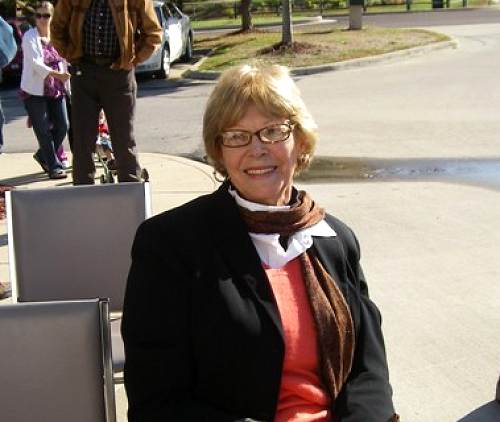
14 Lois Webb
Hi Joe,
Glad to hear the Pope family story -- names I've heard all my life -- and bio of Morgan Dean Pope. I didn't know him except by his presence with his parents, but his maternal grandparents, Cecil and Burt (didn't know his name was Burton) Sullivan lived across the street from my Mace grandparents in Brumley. They chatted often. I do recall Cecil's delight in Morgan Dean's birth and some of her enthusiasm in telling of his infant or early childhood antics. She would surely be proud of his adult accomplishments.
One of our family fun-sayings developed because of Cecil's presence at Grandma Mace's house during the 1938 infancy of Cleo Mace Green's daughter, Gloria Jo. Seems that Cleo and her sister, Ollie, who came from her home in Arkansas to steer the new-baby ship, were well read on modern care of infants. Social history remembers that era when time honored on-demand feeding became archaic and scheduled feeding promised to produce disciplined and/or near perfect behaviors in the next generation.
So, if Gloria cried before her scheduled time of feeding -- tough. Grandma Mace (Maggie), who had raised seven of her ten children to adulthood, reluctantly retreated from her pleas to "feed that baby!" The young mother and aunt had read the current manuals about proper handling of new babies. "But mother, the book says to wait 'till the next scheduled time," retorted her daughters, Cleo and Ollie.
One day, as Cecil Sullivan told the story, which other family members retold frequently, the baby cried, the well-read caretakers first checked the clock's unrelenting feeding schedule, then the baby's diaper. In the meantime, Maggie -- my mind's eye can see her now -- gray hair pulled back in a bun secured by half-inch wide amber colored celluloid hairpins, round wire rimmed glasses on the bridge of her nose, and in this setting, a demeanor of distress -- rocked in the chair she'd pulled up alongside Cecil.
Cecil implied that Grandma's rocking tempo increased as the baby's cries grew louder. The diaper check clued the caretakers that indeed, another problem had arisen. "Oh mother, she's dirtied her diaper" one of them wailed. To which, Cecil reported that Grandma Mace, in full measure of disgust declared with no hesitation -- "Get your book -- get your book!" and she kept right on rocking.
I still remember Cecil's laugh as she told that story -- an incident the rest of us would not have known otherwise. And that's how "Get your book" became a saying in our family when evidence of having ignored common sense showed up in one form or another.
Burt owned the barber shop; haircuts were a quarter; and a pool table in the small building kept many of the townsmen occupied. Sometimes Lee and I got to tag along with dad or one of his brothers, Harrison or Vanus (Slim). To this day, if I hear the sound of pool balls cracking against one another, my mental vision jumps back to the pool-table skill of my dad, uncles and other Brumley men of the time as they shot pool at Burt's Brumley barbershop.
You know, Joe, thinking about that era and the townsmen gathered around Burt's barbershop pool table reminds me of an incident mom (Clare Mace) told me long after dad (Lucian - 1902-1972) died (photo 15).
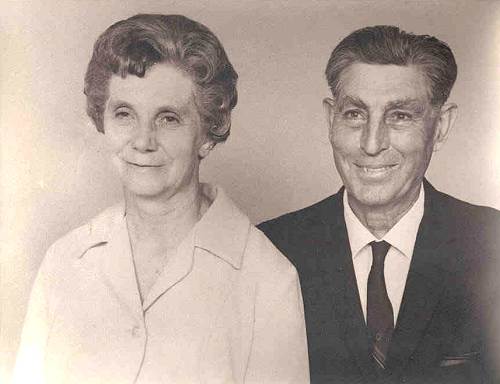
15 Lucian and Clare Mace - 1970
I like the story because it depicts a spirit of community concern as exemplified by some of those very men, friends and contemporaries of my dad and uncles, who wiled away many hours in such occupation as pool, card games like pitch, and poker using matches for the ante. I was more than grown before I learned that people played games of chance with actual money.
Nevertheless, we're talking about the middle 1930s, a time that history would label as the depth of The Great Depression. People, like Burt Sullivan, were fortunate to have developed a trade or skill that would earn an income, albeit meager. Unquestionably my dad and mom, who married in 1926, before the onset of harder economic times, were fortunate to have earned teaching certificates. Dad had a job -- he taught rural schools. And therein lies the crux of the story about community concern of the young men in the 1930s -- a time when gainful employment became a rarity, and card playing or pool shooting became a social ritual for young men around Brumley, and likely many similar communities.
Dad continued the gaming ritual with his friends until one day, one of the men whose name I do not know, though I recall surnames like Brown, Markle, Wall, and Martin, called dad aside for a talk. Mom related the story with a great deal of tenderness as the intent of the "talk" had grown more apparent through the years of cultural change.
"You have a job," the man said. "and you work with young people. The rest of us do not even have jobs, much less a position to influence anyone." The essence of mom's story continued. "As much as we enjoy your friendship, we think your being seen playing these games of chance with us is not in the best interest of the young people around town and besides, they need someone to look up to and it shouldn't be us."
Well, there was no doubt more to the dialogue, but you get the gist. I feel sure the phrase "role model" had not found its way into popular culture at that time. Likewise I speculate, according to the tender emotions mom expressed as she told the story, that the "talk" humbled both my dad and mom more than she had words to say. Just the same, the incident spoke about the concern shown by a set of Brumley's young unemployed male adults during the depth of The Great Depression. And further, I recall lifelong bonds of friendship maintained between my parents and some of those families whose surnames were mentioned.
Thanks Lois. You can read more about Lucian and Clare Mace on a previous Progress Notes at this URL:
http://www.millercountymuseum.org/080825.html
That's all for this week.
|



